#The Ediacaran Period
Text
Time Travel Question 36: Prehistory (Iteration Unknown)
These Questions are the result of suggestions from the previous iteration.
Please add new suggestions below if you have them for future consideration. All cultures and time periods welcome.
#Time Travel#Prehistory#Paleontology#Dinosaurs#Perucetus#Pangea#Campanian Ignimbrite Supervolcano#The Ediacaran Period#Evolution#Extinct Animals#Diplodicus#Deinonychus#Acrocanthosaurus#The Glen Rose Trackway Hunt#Andrewsarchus
376 notes
·
View notes
Text
lil guys of the Ediacaran
the Ediacaran period was around ~635 million years ago, happening before the Cambrian. This time saw the rise of the first group of animals and the oldest multicellular life. The fossil record is sparse due to the fact that the creatures did not have hard shells, which are the thing most easily fossilised.
the Ediacaran biota appeared ~570 million years ago, and are very taxonomically ambiguous, they may relate to some groups, like cnidaria and protozoans, but some have suggested completely new phylums that we do not have today.
the majority of Ediacaran biota were sessile (lacking the ability to move by themselves) and were soft-bodied. many also lacked mouths and a gut.
here are some lil guys!

These frondose fossils are very controversial, considering they appear to be leafy plants, but may very well be anything from animal or protist, to stem fungi (https://www.science.org/doi/10.1126/science.1099727)

this is an Erniettamorph and we know basically nothing about these! The fossils were found in places where photosynthesis would not have been possible, and one type of these fossils has been found with the tubes completely covered and filled with sand, which makes the possibility of osmotic feeding from the surrounding water difficult as it would reduce the metabolically active volume. (https://www.pnas.org/doi/full/10.1073/pnas.0904836106)

Dickinsonia is a more studied animal. and it probably was an animal, due to cholesterol molecules found in fossils. Fossils range from millimetres to ~1.4 metres, and have near bilateral symmetry and rib-like segments. They were a mobile creature and ate microbial mats (trace fossils have been found which are most likely impressions from feeding) (https://doi.org/10.1017/S175569102300004X) A study from 2022 has suggested that they temporarily stuck themselves to substrate with mucus, which suggests a life in shallow waters (https://doi.org/10.1017/S0016756821000194)
support me on ko-fi?
#some of these articles are not freely available#so i might get the pdfs for people and drop them in a google drive if people would like#marine biology#ediacaran period#eddie in the ocean#dickinsonia#erniettamorph#frondose#fossils#paleontology#im on a paleo posting spree because this is what we r doing in lectures#i think ive had one singular lecture about modern animals (it was a cephalopods one)#oh wait no i had one on cnidaria and porifera ignore me#queue are in the ocean
48 notes
·
View notes
Text

paleoart but its on paint and only probably an animal?
#aka i wanted to draw my favourite 'animal's#aka funky impressions in the ediacaran rocks!#charnia#thectardis#its the thing i drew before but i added charnia masoni this time!#thectardis isnt found in ediacara from memory only mistaken point#BUT IM TALKING ABOUT EDIACARAN ROCKS AS THE GEOLOGICAL TIME PERIOD NOT THE LOCATION
22 notes
·
View notes
Text
fungi are so fucking cool, man.
-They were some of the first non-microbial life to colonize land (before plants, even!), and they're so efficient when it comes to breaking down materials that mycoremediation is one of the cheapest and most effective ways to pull various toxins and heavy metals out of a given environment.
-some of them glow in the fucking dark
-their cell walls contain chitin, which is also found in arthropod exoskeletons (fungi are also more closely related to US than they are to plants. wild)
-A specific clonal colony of honey fungus could be one of the largest organisms on earth by biomass.
and probably a lot more but thats all i have for now
#tibtalks#i have a huge fascination with like#the paleozoic era and how non microbial life got its start#also the ediacaran period as well
7 notes
·
View notes
Text

Imagine dying and then finding out that 510 million years later people are saying you look strange and calling you a failed experiment
#sorry everyone my brain has been consumed by thoughts about the#ediacaran period#that was supposed to be one tag but I'm not going to fix it#Btw for my followers who know nothing about the ediacaran period this theory is only one of many#this is not the scientifically accepted theory of what happened to the ediacaran beasts#(idk what to call them bc we don't know wtf they are)#(they might be animals but they are also equally likely to be literally anything else)
4 notes
·
View notes
Text
why am i incapable of finding a map of the plate tectonics of the earth 570-550 million years ago at the present moment :(
#like theres maps of the earth in the ediacaran period#and my maps i mean about two or three of them#i dont understand rocksssssssssssss ;_;#i just wanna know if there was any seeps near Charnia masoni :(#like was it near a hydrothermal vent??#ive got no fucking clue! :D
10 notes
·
View notes
Text
anyone else feel a strange connection to Ediacaran fossils?
1 note
·
View note
Text
One paleoart for each period since the Cryogenian
Thanks to the timeline on my walls that I've been trying to fill in with my art, I have now reached the point where I've done paleoart for every single period of the Phanerozoic, plus the Ediacaran and Cryogenian! That is to say, every period of the last 700 million years. So with that milestone, I thought it'd be fun to go through those periods in order and show off one paleoart of mine for each!
Cryogenian

In the Cryogenian, the Earth completely froze over. Twice! Life wasn't much to look at yet, but I enjoyed drawing what our planet might have looked like at the time. The girdle of lakes at the left is the equator, which may have had ice-free patches.
Ediacaran
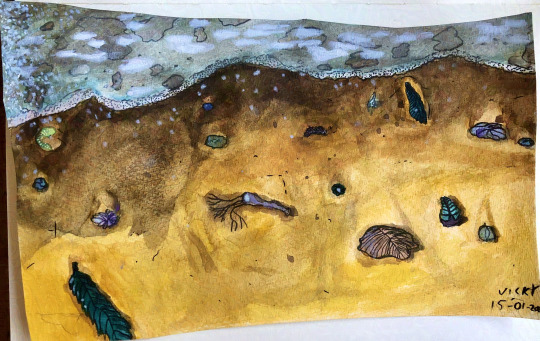
When the ice retreated, animals first began to blossom into their endless forms most beautiful. Ediacaran life was strange and quite unlike the creatures that would come later, but it was nonetheless an incredibly important chapter in life's history. Here we see the Ediacaran weirdos washing up on shore after a storm.
Cambrian

The Cambrian explosion brought much more recognisable creatures. But one thing that's easy to miss is that they were all tiny! All of them? No, Anomalocaris was, with a length of about 40 cm, the dragon of the Cambrian.
Ordovician

Life continued to diversify in the Ordovician, and among this diversity were the cephalopods. They produced the largest animals yet to exist, the orthocones, who hung vertically in the water column and decended upon their prey like a claw game.
Silurian
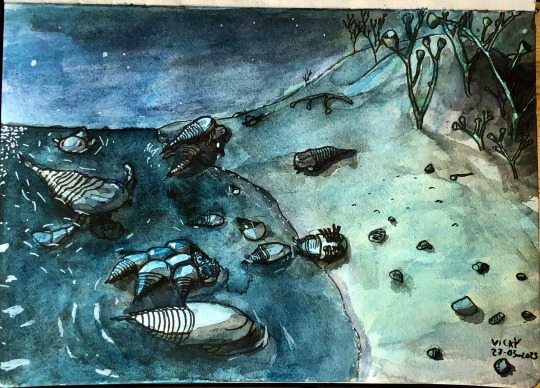
Although fungi and bacteria had already made forays onto the land deep in the past, things began to get busier there in the Silurian. But these horseshoe crabs, and their larger cousins the sea scorpions, have not come to the shore to stay, but to mate and lay eggs. Unfortunately for the horseshoe crabs, they have come to the very same shore.
Devonian
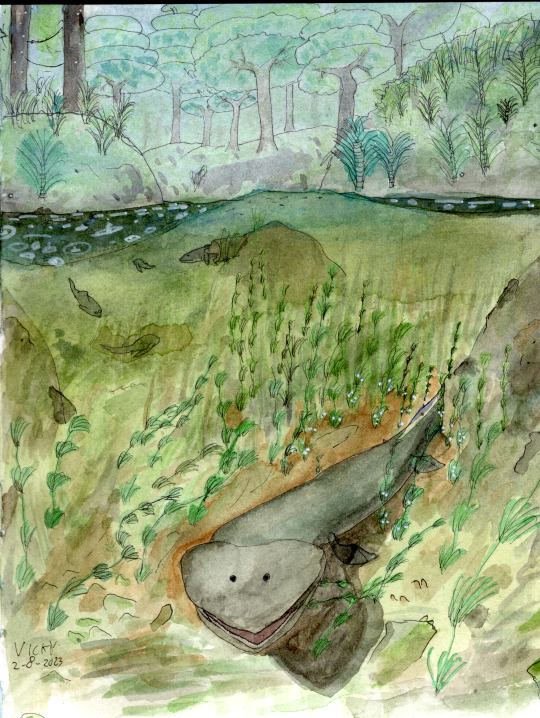
Our own vertebrate ancestors, like Tiktaalik, were pretty late to the party, only taking their first steps on land in the late Devonian. That's no knock against them - there was plenty to do underwater! This Tiktaalik is busy guarding his eggs while his mate is busy hunting, for example. Who has time to step on land?
Carboniferous

The end of the Carboniferous saw some quite large bugs, like these two Mazothairos chasing off an interloping Meganeura. They're representatives of a pretty interesting group of basal insects called the Palaeodictyoptera, who have a set of weird little extra wings on their thorax.
Permian
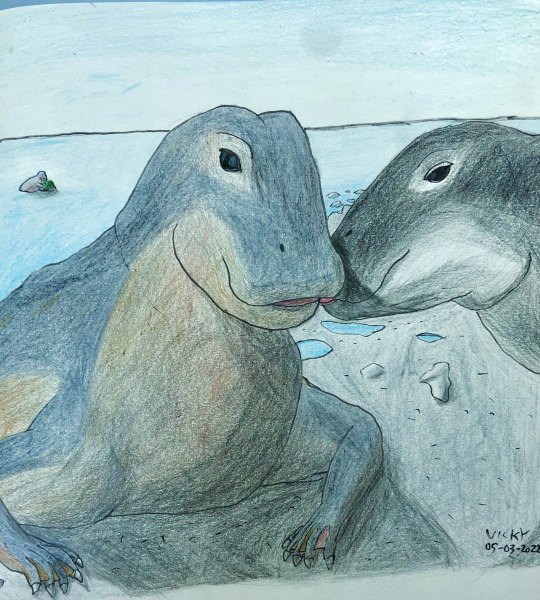
Among the many fantastic creatures of the Permian were our own cousins, the synapsids, like these lovey-dovey Moschops. As you can see, this picture and the previous one are done in coloured pencils instead of watercolour, because they're the oldest images I'm including in this post. I only very rarely used watercolours before this year. I think it means I should do some more Permian art, it's such a cool and underexposed period.
Triassic
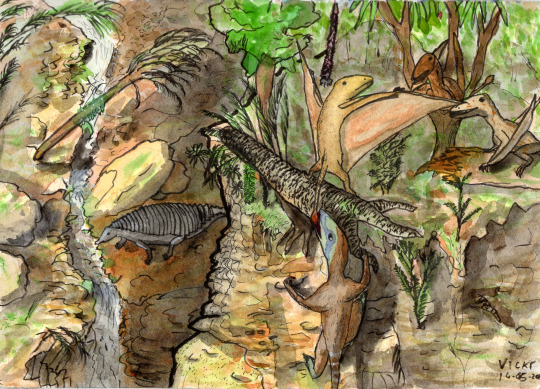
One mass extinction later, the archosaurs are diversifying all over Triassic Pangaea. Here we have the three main groups of them: Paratypothorax, a pseudosuchian in the background; Peteinosaurus, a pterosaur on top of the cliff; and Procompsognathus, a dinosaur climbing the cliff.
Jurassic

I had three different option for Jurassic paleoart to showcase, so I picked the most experimental one. These backlit insects are not butterflies, but kalligrammatids, a group of large-winged neuroptera, some of which even mimicked maniraptoran dinosaurs like this iridescent Caihong with their patterns.
Cretaceous
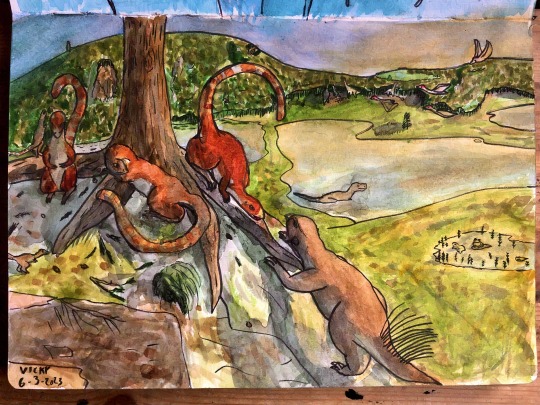
The Cretaceous featured some of life's most gorgeous crescendos of diversity, like the Yixian formation, where a Psitaccosaurus wants to visit the favourite tree of a group of Sinosauropteryxes, who are having none of it. This is still one of my favourite pieces I've ever drawn.
Paleogene
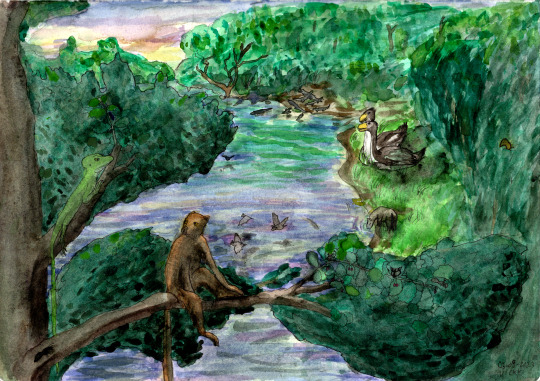
The Paleogene featured some of the highest global temperatures of all time, leading to tropical climates all over the planet, including at this lake in what will one day be Messel, Germany. Darwinius, a close cousin to our own ancestors, is having a staredown with the lizard Geiseltaliellus.
Neogene

The world turned colder and dryer in the Neogene, leading to the spread of large grasslands, like these South American ones. Phorusracos, a large terror bird, has caught a Thoatherium on the edge of the forest they both live in. South America was an isolated continent for the duration of the Neogene, leading to a quite unique fauna.
Quaternary

The Quaternary, our current period, is marked by the cycle of ice ages regularly freezing the northern hemisphere. But even during the ice ages, spring would come to the mammoth steppes, and these steppe mammoths are happy to celebrate its coming with a bath in the river.
#paleoart#my art#palaeoblr#timeline#no i am not gonna tag everything in it#the pictures should all work as links to the individual posts of these pieces#cw: animal death#cw: bugs#cw: parasites#cw: blood
305 notes
·
View notes
Text
Happy New Year!
Let's imagine it was the Earth itself that was going into its 2024th year. That is to say, we're compressing the entire history of the Earth into just the past 2023 years. What events would have happened when?
Well, not too much is certain about the first couple decades after our planet formed, until around 50 CE when we were hit by another proto-planet, Theia, and the debris formed the Moon. After a couple years of the planet cooling down again, the oceans formed out of boiling rain. The timing of the origin of life is very uncertain, but there are chemical signs it may very well have happened as early as the second century. Around 200 CE, the gas giants did a big funky orbit-swapping dance, and in the process inflicted the Late Heavy Bombardment on the rest of the solar system, meaning the Earth was suffering a ton of meteorite strikes for the entire third century.
The first indisputable evidence of life is from around 330, and the first stromatolites appear around 470. Those are basically the first fossils, stones created by layer upon layer of oxygen-producing cyanobacteria living and dying on top of one another. But even with oxygen producers evolving, it would take many centuries before oxygen became a major part of the atmosphere: not until the Great Oxygenation Event, which happened during the ninth and tenth centuries. That's also about the time the first complex, eukaryotic cells evolved through a symbiosis between an anaerobic archaean and an oxygen-breathing bacterium. The bacterium became more and more focused on just the oxygen-breathing task inside the larger cell, until its descendants were mitochondria, which as you all know are the powerhouse of the cell. The next seven centuries passed by with only slow, gradual changes, and life continuing to be unicellular and difficult to find in the fossil record.

(1735's Snowball Earth, by me)
From 1704 to 1730, the entire planet froze over. After merely two years of thaw, it happened again, this time lasting from 1732 to 1742. But these snowball Earth episodes set the stage for the evolution of animals that began right after. Across the mid-18th century, the bizarre Ediacaran biota, with its strange symmetries, fronds, and fractal-like pattern filled the oceans. In the early 1780s they went extinct, possibly due to a temporary drop in oxygen-levels, only to be replaced by a great variety of quite different creatures in the Cambrian Explosion.
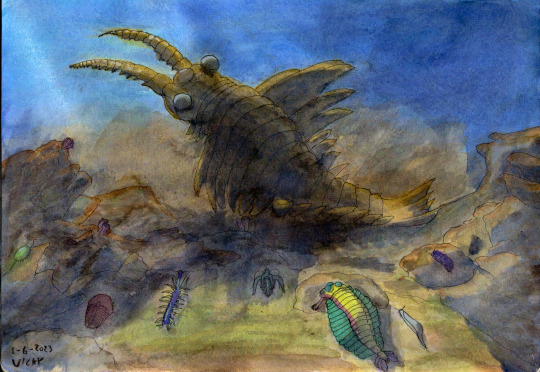
(Class of 1799, by me)
Starting in 1784 and running for a few decades, the Cambrian period saw the origin of most of the modern animal phyla, reaching its most famous form in the Burgess Shale fauna of 1799. During this time, most animals still lived on the sea floor, either attached or crawling, with relatively few actually swimming creatures. Plants started tentatively moving onto land around 1817, and in 1825, the rising of the great Appalachian mountains caused a severe drop in global CO2 and thus temperatures, leading to the Late Ordovician mass extinction.

(Horseshoe crabs and sea scorpions on a beach in 1834, by me)
Bony fish first showed up during the 1830s, and around the same time plants were getting serious about inhabiting the land, evolving roots and vascular tissues so they could properly grow there. Millipedes and the ancestors of spiders were the first animals to follow them onto land. Our own fishy ancestors did not take their first step until 1857, by which point the arthropods were well established there and the plants had figured out how to become trees. The Late Devonian extinction, partially caused by the evolution of said trees and partially by the south pole freezing, played out in two pulses over the late 1850s and early 1860s.
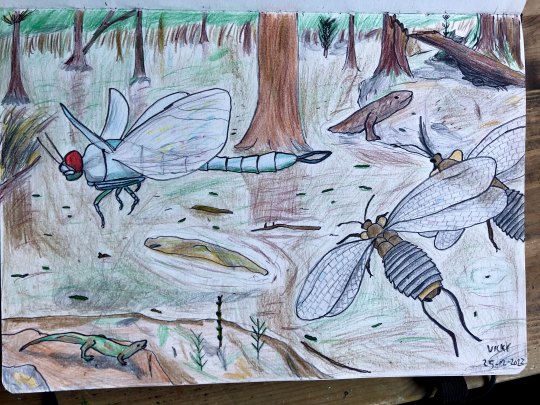
(Swamp prominently featuring Meganeura and Mazothairos in 1889, by me)
Arthropods and vertebrates continued to gain adaptations to life on land. The insects became the first creatures ever to fly in 1878, and the high-oxygen atmosphere of the time would be especially good to them. Around 1884, a group of vertebrates called the amniotes, after the membrane that kept water inside their eggs so they could lay them on land without them drying out, split into two groups: the reptiles and the synapsids (which we mammals descend from). The next few decades would see the synapsids in particular being extremely successful as the supercontinent Pangaea formed. Until 1912, when a massive episode of volcanism caused the worst mass extinction of all time, the Great Dying, scouring the Earth of a huge portion of its life.
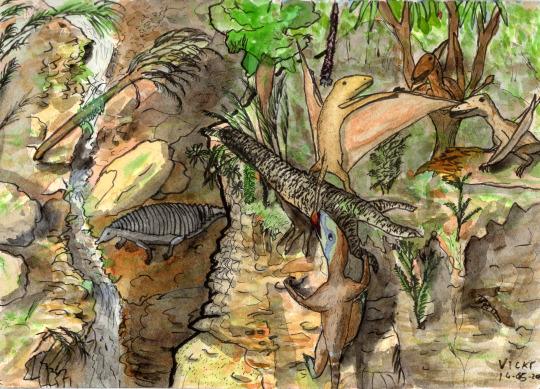
(A 1930 scene featuring the three branches of archosaur: dinosaur, pterosaur, and pseudosuchian, by me)
The 1910s were a period of slow recovery during which strange new forms of animal evolved. Many different, unrelated reptiles, such as the ichtyosaurs and plesiosaurs, went to sea, where they would continue to provide some of the most impressive creatures for most of the 20th century. On land, the dinosaurs first appeared in 1920, though for the next decade or so they'd live in the shadow of their pseudosuchian (crocodile-line) cousins. In 1934, Pangaea began to break up, resulting in another terrible pulse of volcanism that caused a lot of extinctions and left particularly the feathered and furry survivors with a lot of empty niches to fill, allowing the dinosaurs and mammals to diversify greatly. The last common ancestor of all modern mammals lived in the early 1940s, and by 1957 the dinosaurs had figured out flight, with Archaeopteryx usually being considered the first bird. Other dinosaurs took on an incredible variety of sizes, shapes, and forms. Some of the most famous ones include Dilophosaurus (1942), Diplodocus and Stegosaurus (1955), Iguanodon (1969), Velociraptor (1991), and Tyrannosaurus rex (1994).

(A tropical lakeside in the year 2000, by me)
In 1995, the world was struck by a meteorite, wiping out many groups, including the marine reptiles, pterosaurs, and ammonites. The surviving mammals and dinosaurs went on to diversify across the next couple of years and had formed thriving new ecosystems in the tropical world of the turn of the millennium. The first known bat lived in 2001, and the whales returned to the oceans next year. Around 2009, the world's climates turned colder and dryer. Antarctica froze over and grasslands spread widely. Our last common ancestor with the chimpanzees and bonobos lived in 2021, and by new year 2023, our ancestors were getting brainier and more proficient with tools. That's also when the north pole froze and the Quaternary ice age cycle began. The first known members of Homo sapiens lived on 10 November 2023. The latest ice age started on 14 December, and ended at 2 AM on 30 December. The great pyramid of Giza was built at 6 AM on 31 December and On The Origin Of Species was published at 23:22 PM.
#palaeoblr#happy new year#2024#geologic timescale#vicky's vritings#one year is 2.244 million years if you're curious#and yes i did exclude both year 0 and 2024#since 0 doesn't exist and 2024 hasn't happened yet#my art#i rather enjoy having an extensive collection of my art to illustrate my paleorambles nowadays#incidentally the big bang occurred in 4121 bce at this scale#which is curiously close to the date of creation creationists made up#if only they would follow through and insist humanity itself was seven weeks old too
124 notes
·
View notes
Text
sea pens are so fascinating. did you know they exist?
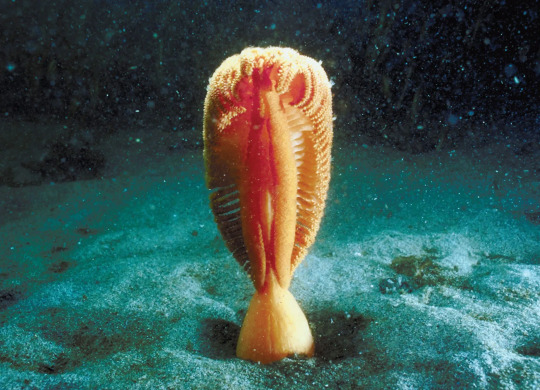
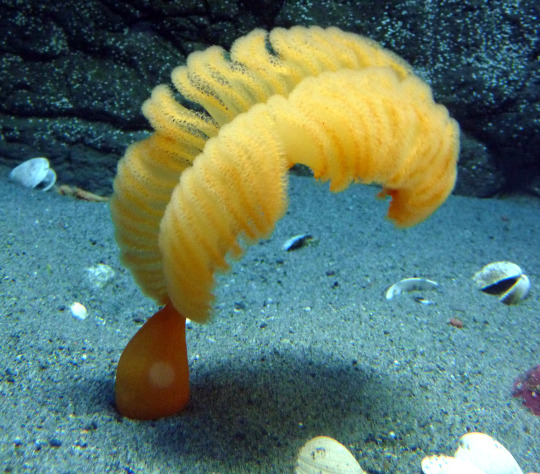
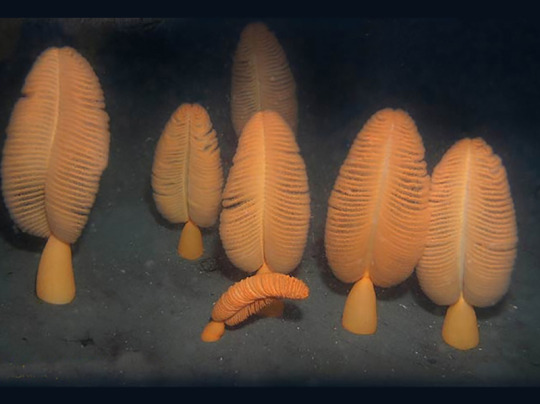
sorry sir, wrong time period. did you mean to be in the late ediacaran?
3K notes
·
View notes
Text
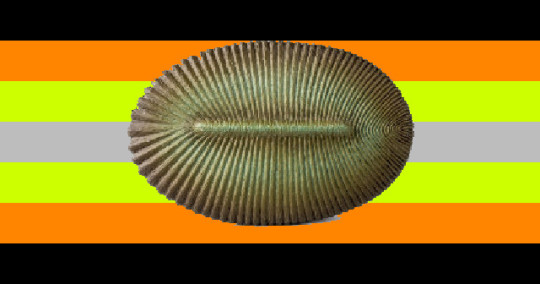
Dickinsonia from the Ediacaran Period is Forklift Certified!
144 notes
·
View notes
Text
Time Travel Question 48: Early Modernish and Earlier 3
These Questions are the result of suggestions a the previous iteration.This category may include suggestions made too late to fall into the correct earlier time grouping. In some cases a culture lasted a really long time and I grouped them by whether it was likely the later or earlier grouping made the most sense with the information I had. (Invention ofs tend to fall in an earlier grouping if it's still open. Ones that imply height of or just before something tend to get grouped later, but not always. Sometimes I'll split two different things from the same culture into different polls because they involve separate research goals or the like).
Please add new suggestions below if you have them for future consideration. All cultures and time periods welcome.
#Time Travel#Paracelsus#Early Modern#Precolonization#Indigenous Cultures#Aphra Behn#Il Sodoma#Art History#Theater History#Espionage#The Man in the Iron Mask#Yellowstone#Indigenous History#18th Century#17th Century#Serial Killer#Nursery Rhymes#Nanny of the Maroons#Escaped Slaves#Jamaica#1600s#1700s#Caribbean History#Black Women's History#Black History#Women's History#Ediacaran Era#Neoproterozoic Era#Ancient Iberian Cultures#Iberian History
51 notes
·
View notes
Note
i once read a scifi book where prisoner colonists were sent to a planet where everything evolved based on reeds and threes/triangles. does anything on earth have an odd number of limbs etc? or why not?
starfish do!
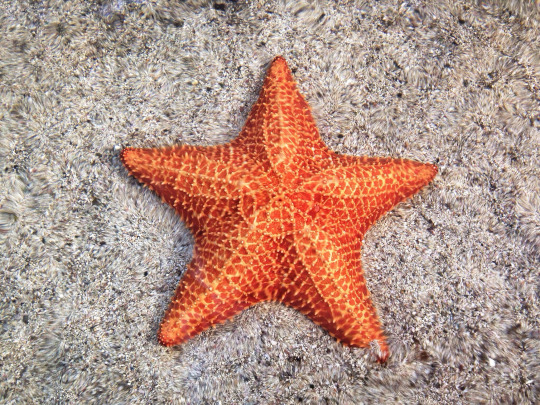
and many of the bizarre animal precursors of the Ediacaran period had trilateral symmetry, instead of radial or bilateral symmetry like we have today.

tragically though this trait didn't catch on, and died out with the rest of the animal precursors once true animals showed up on the scene and started immediately fucking shit up.
so yeah, maybe there's a planet out there somewhere where THAT body plan was the one that survived instead!
863 notes
·
View notes
Text
Strange Symmetries #01
Most animals are bilaterally symmetric, having body plans with mirrored left and right sides – which also allows them to have a defined head end, rear end, top side, and underside.
It's not entirely clear what evolutionary advantage this type of symmetry gave to the first bilaterians, which would have been been small "simple" worm-like animals living sometime during the Ediacaran Period between 600 and 560 million years ago. The current generally accepted explanation is that it probably allowed for better active locomotion – clustering sense organs at the head end and directing body movement more efficiently towards food sources and away from threats.
However, this sort of symmetry is never completely perfect. Internal structures like organs are often arranged nonsymmetrically, and the realities of genetics, physical development, and environmental influences always result in external small deviations.

Zebra From The Back by Lynn Greyling | CC0 Public Domain
…But not every bilaterian has stayed roughly symmetrical.
Over the last half-billion years or so some bilaterians have abandoned their roughly-mirror-image body plans in favor of something distinctly wonkier. Asymmetry has evolved multiple times in various different lineages, and so every weekday this month we'll be looking at some examples.
And we might as well start way back near the beginning:
———
Strange Symmetries #01: Almost Bilateral
Living in the Ediacaran between about 567 and 550 million years ago, the proarticulatans were flattened rounded organisms with two rows of soft "quilted" rib-like segments (known as isomers) and sometimes a larger fused "head" section at the front. The left and right isomers weren't perfectly mirrored, instead being offset from each other in a glide reflection pattern – but the presence of a clear central body axis suggests these animals may have had some sort of relation to the earliest bilaterians, possibly even being a very early stem group that was experimenting with a not-quite-totally-bilateral body plan.

Discovered in what is now northwest Russia, and dating to around 555 million years ago, Vendia sokolovi was a small proarticulatan measuring about 1.1cm long (0.4"). It had a rather small number of isomers compared to some of its relatives, only 7 per side, and seems to have had a simple digestive tract that branched into each isomer.
(The superficial resemblance to trilobites was coincidental – while we might not be entirely sure what these things were, we do at least know they weren't closely related to early arthropods.)
Very little overall is known about these animals' lifestyles. Trace fossils suggest they were able to move around, feeding on microbial mats on the seafloor, and they may also have been able to firmly stick themselves onto the spots they were currently grazing.
———
NixIllustration.com | Tumblr | Twitter | Patreon
#science illustration#strange symmetries#paleontology#paleoart#palaeoblr#vendia#proarticulata#ediacaran#bilateria#maybe#art#asymmetry#glide reflection
253 notes
·
View notes
Text
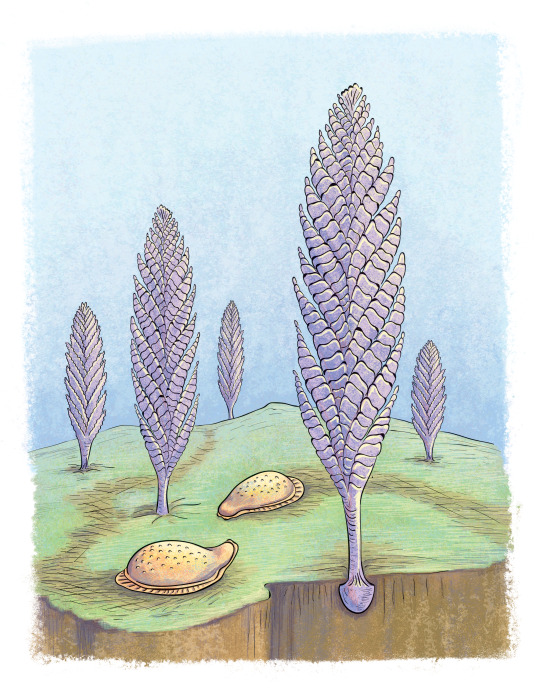
I made a small attempt at some paleo-reconstruction! Here we have a couple creatures from the White Sea assemblage--Kimberella and Charnia. I choose to believe the Ediacaran period was soft and pastel colored
51 notes
·
View notes
Text
I know you've all been waiting eagerly for it, and here it is: the first Wikipedia poll of the new year! Links and summaries below the cut as always.
On 29 September 1940, a mid-air collision occurred over Brocklesby, New South Wales, Australia. The accident was unusual in that the aircraft involved, two Royal Australian Air Force (RAAF) Avro Ansons of No. 2 Service Flying Training School, remained locked together after colliding, and then landed safely.
On 11 May 1812, at about 5:15 pm, Spencer Perceval, the prime minister of the United Kingdom of Great Britain and Ireland, was shot dead in the lobby of the House of Commons by John Bellingham, a Liverpool merchant with a grievance against the government. Bellingham was detained; four days after the murder, he was tried, convicted and sentenced to death.
The Dorset Ooser (/ˈoʊsər/) is a wooden head that featured in the 19th-century folk culture of Melbury Osmond, a village in the southwestern English county of Dorset. The head was hollow, thus perhaps serving as a mask, and included a humanoid face with horns, a beard, and a hinged jaw which allowed the mouth to open and close.
The Ediacaran (/ˌiːdiˈækərən/; formerly Vendian) biota is a taxonomic period classification that consists of all life forms that were present on Earth during the Ediacaran Period (c. 635–538.8 Mya). These were enigmatic tubular and frond-shaped, mostly sessile, organisms. Trace fossils of these organisms have been found worldwide, and represent the earliest known complex multicellular organisms.
John Rykener, also known as Eleanor, was a 14th-century sex worker arrested in December 1394 for performing a sex act with John Britby, a man who was a former chaplain of the St Margaret Pattens church, in London's Cheapside while wearing female attire. Although historians tentatively link Rykener, who was male, to a prisoner of the same name, the only known facts of the sex worker's life come from an interrogation made by the mayor of London.
Norwich Market (also known as Norwich Provision Market) is an outdoor market consisting of around 200 stalls in central Norwich, England. Founded in the latter part of the 11th century to supply Norman merchants and settlers moving to the area following the Norman conquest of England, it replaced an earlier market a short distance away. It has been in operation on the present site for over 900 years.
Olive Elaine Morris (26 June 1952 – 12 July 1979) was a Jamaican-born British-based community leader and activist in the feminist, black nationalist, and squatters' rights campaigns of the 1970s. At the age of 17, she claimed she was assaulted by Metropolitan Police officers following an incident involving a Nigerian diplomat in Brixton, South London. She joined the British Black Panthers, becoming a Marxist–Leninist communist and a radical feminist.
Paul Palaiologos Tagaris (Greek: Παῦλος Παλαιολόγος Τάγαρις, c. 1320/1340 – after 1394) was a Byzantine Greek monk and impostor. A scion of the Tagaris family, Paul also claimed a somewhat dubious connection with the Palaiologos dynasty that ruled the Byzantine Empire at the time. He fled his marriage as a teenager and became a monk, but soon his fraudulent practices embroiled him in scandal.
The Royal baccarat scandal, also known as the Tranby Croft affair, was a British gambling scandal of the late 19th century involving the Prince of Wales—the future King Edward VII. The scandal started during a house party in September 1890, when Sir William Gordon-Cumming, a lieutenant colonel in the Scots Guards, was accused of cheating at baccarat.
In a protracted conflict during the Spanish colonization of the Americas, Spanish colonisers gradually incorporated the territory that became the modern country of Guatemala into the colonial Viceroyalty of New Spain. Before the conquest, this territory contained a number of competing Mesoamerican kingdoms, the majority of which were Maya.
32 notes
·
View notes